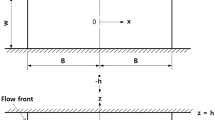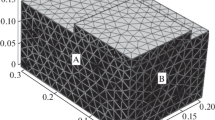Abstract
The material targeted in this study is TEPEX® flowcore, a long glass fiber mat reinforced polyamide (PA6/GF) manufactured by Lanxess. The material is classified experimentally on coupon level, and the kinetic behavior is analyzed through standard and flash DSC analyses. Subsequently, results from experimental molding trials are investigated concerning material forming and material flow. Finally, molding behavior is analyzed on a predictive basis using a thermokinetic and a rheological model. It is found that molding of the PA6 GMT comprises the sequential stages of material forming and material forming, in combination with the respective defects wrinkling and incomplete mold filling. Flowability is found to be rather limited, given the usually adopted thin stacking heights (\(\lesssim 8 \, \text {mm}\)), a minimum achievable part thickness (\(> 3 \, \text {mm}\)), and a maximum specific pressure (\(< 500 \, \text {bar}\)). Finally, it is shown that the experimentally observed no wall slip results from an instant solidification of the sheet surface due to the significant difference in mold wall and charge temperature.























Similar content being viewed by others
References
Schemme M (2008) LFT - development status and perspectives. Plastics, Additives and Compounding 10(2):38–43
Kutz M (2017) Applied plastics engineering handbook: processing, materials, and applications. Plastics design library PDL handbook series. Elsevier/William Andrew, Amsterdam and Boston and Heidelberg, second edition edition
Bruderick M, Denton D, Shinedling M, Kiesel M (2002) Applications of carbon/fiber SMC for the 2003 Dodge Viper. Second SPE Automotive Composites Conference (vol 10)
Gardinger G (2016) Is the BMW 7 series the future of autocomposites?
Burn D (2016) Long discontinuous carbon fibre/polypropylene composites for high volume automotive applications. Doctoral thesis, University of Nottingham, Nottingham
Davis BA, Gramann PJ, Osswald PJ, Rios AC (2003) Compression molding. Hanser, Munich
Grove DA (2005) Composite processes. In: Harper CA (ed) Handbook of Plastic Processes. John Wiley & Sons Inc, Hoboken, NJ, USA, pp 475–527
Osswald TA (1998) Polymer processing fundamentals. SPE books, Hanser and Hanser/Gardner, Munich and Cincinnati
Wakeman MD, Rudd CD (2000) Compression molding of thermoplastic composites. In Comprehensive Composite Materials, pp 915–963. Elsevier
Jespersen ST, Baudry F, Schmäh D, Wakeman MD, Michaud V, Blanchard P, Norris RE, Månson J-AE (2009) Rapid processing of net-shape thermoplastic planar-random composite preforms. Appl Compos Mater 16(1):55–71
Haque E, Bristow P, Giles H (2001) Processing of glass fiber mat reinforced thermoplastic composites. Dallas, TX: Society of Plastics Engineers ANTEC 2001:2079–2083
Bernet N, Michaud V, Bourban P-E, Månson J-AE (2001) Commingled yarn composites for rapid processing of complex shapes. Compos A: Appl Sci Manuf 32(11):1613–1626
Sattar S, Beltran Laredo B, Pedrazzoli D, Zhang M, Kravchenko SG, Kravchenko OG (2022) Mechanical behavior of long discontinuous glass fiber nylon composite produced by in-situ polymerization. Compos A: Appl Sci Manuf 154:106779
Heer N, Ivanov S, Meirson G, Ugresic V, Henning F, Hrymak A, Zhang M (2020) Versatility of Long Fiber AP Nylon CR-6 Organosheet to overcome intrinsic short comings of Long Fiber Thermoplastics. SPE-ACCE 2020 conference proceedings
Dörr D, Singh-Heer N, Gergely RCR, Schreyer L, Henning F, Straatman AG, Hrymak A (2022) Rheological characterization and macroscopic modeling and simulation of the molding process of a PA6 glass mat thermoplastic (GMT). Journal of Composites: Part A (revision submitted)
Dörr D, Singh-Heer N, Gergely RCR, Okonski D, Henning F, Straatman AG, Hrymak A (2022) Towards a virtual process chain for glass mat thermoplastics as a basis for digital product development. SPE ACCE Proceedings
Dörr D, Gergely R, Ivanov S, Kärger L, Henning F, Hrymak A (2020) On the applicability of thermoforming characterization and simulation approaches to glass mat thermoplastic composites. Procedia Manufacturing 47:118–125
Dörr D, Ivanov S, Gergely R, Meyer N, Henning F, Straatman AG, Hrymak A (2021) A sequential approach for simulation of thermoforming and squeeze flow of glass mat thermoplastics. ESAFORM 2021
Xu C, Ivanov S, Gergely R, Dörr D, Hrymak A, Henning F (2021) Characterization of heat transfer parameters in the compression molding of glass mat thermoplastics. SPE ACCE Proceedings
Knezevic D, Tutunea-Fatan OR, Gergely R, Okonski DA, Ivanov S, Dörr D (2022) Thermographic analysis of a long fiber-reinforced thermoplastic compression molding process. The International Journal of Advanced Manufacturing Technology 119(9–10):6119–6133
Lanxess (2017) Material data sheet Tepex flowcore 102-RGR2400/47%
AZO Materials (2022) E-glass fibre, January 27, 2022
Krause M, Hausherr JM, Burgeth B, Herrmann C, Krenkel W (2010) Determination of the fibre orientation in composites using the structure tensor and local X-ray transform. J Mater Sci 45(4):888–896
Pinter P, Dietrich S, Bertram B, Kehrer L, Elsner P, Weidenmann KA (2018) Comparison and error estimation of 3D fibre orientation analysis of computed tomography image data for fibre reinforced composites. NDT & E International 95:26–35
Advani SG, Tucker CL (1987) The use of tensors to describe and predict fiber orientation in short fiber composites. J Rheol 31(8):751–784
Kanatani K-I (1984) Distribution of directional data and fabric tensors. Int J Eng Sci 22(2):149–164
Dahl J, Blashard P, Latimer T, Sudria J, Henshaw J (2011) A method for characterizing fiber length distribution in random fiber composites. Society of Plastics Engineers - 11th-Annual Automotive Composites Conference and Exhibition
National Institutes of Health (2022) Image J: image processing and analysis in Java
Dörr D, Joppich T, Kugele D, Henning F, Kärger L (2019) A coupled thermomechanical approach for finite element forming simulation of continuously fiber-reinforced semi-crystalline thermoplastics. Compos A: Appl Sci Manuf 125:105508
Haanappel SP, ten Thije RHW, Sachs U, Rietman B, Akkerman R (2014) Formability analyses of uni-directional and textile reinforced thermoplastics. Compos A: Appl Sci Manuf 56:80–92
Kugele D (2020) Experimentelle und numerische untersuchung des abkühlverhaltens thermoplastischer gelegelaminate in der prozesskette
Baehr HD, Stephan K (2006) Heat and mass transfer. Springer-Verlag Berlin Heidelberg, Berlin, Heidelberg, second revised edition edition
Nakamura K, WatanabeT, Katayama K, Amano T (1972) Some aspects of nonisothermal crystallization of polymers. i. relationship between crystallization temperature, crystallinity, and cooling conditions. Journal of Applied Polymer Science 16(5):1077–1091
Patel RM, Spruiell JE (1991) Crystallization kinetics during polymer processing–analysis of available approaches for process modeling. Polymer Engineering & Science 31(10):730–738
Kugele D, Dörr D, Wittemann F, Hangs B, Rausch J, Kärger L, Henning F (2017) Modeling of the non-isothermal crystallization kinetics of polyamide 6 composites during thermoforming. AIP Conference Proceedings 1896:030005
Hoffman JD, Weeks JJ (1962) Rate of spherulitic crystallization with chain folds in polychlorotrifluoroethylene. The Journal of Chemical Physics 37(8):1723–1741
Ziabicki A (1976) Fundamentals of fibre formation: the science of fibre spinning and drawing. Wiley, London u.a
Feng N, Wang X, Wu D (2013) Surface modification of recycled carbon fiber and its reinforcement effect on nylon 6 composites: mechanical properties, morphology and crystallization behaviors. Curr Appl Phys 13(9):2038–2050
Kalaidov M, Meirson G, Heer N, Fan Y, Ivanov S, Ugresic V, Wood J, Hrymak A (2019) Viscosity measurement technique for long fiber thermoplastic material. SPE ACCE Proceedings
Macosko CW (1994) Rheology: principles, measurements, and applications. Advances in interfacial engineering series, VCH, New York, NY
Mavridis H, Hrymak AN, Vlachopoulos J (1988) The effect of fountain flow on molecular orientation in injection molding. J Rheol 32(6):639–663
Kamal MR, Goyal SK, Chu E (1988) Simulation of injection mold filling of viscoelastic polymer with fountain flow. AIChE Journal 34(1):94–106
Mavridis H, Bruce GD, Vancso GJ, Weatherly GC, Vlachopoulos J (1992) Deformation patterns in the compression of polypropylene disks: experiments and simulation. J Rheol 36(1):27–43
Osswald TA, Rudolph N (2015) Polymer rheology: fundamentals and applications. Hanser Publications Cincinnati
Acknowledgements
The authors greatly appreciate the flash DSC work completed by Xiaoshi Zhang at Penn State Behrend. Moreover, the authors gratefully appreciate the carefully carried out fiber orientation analysis by Trevor Donald Sabiston (University of Waterloo), as well as the professional support on the shop floor by Rob Cosh, Steve Jones, and Keith Ruck (Fraunhofer Innovation Platform @ Western).
Funding
The authors acknowledge the funding support of General Motors of Canada, Natural Sciences and Engineering Research Council of Canada (Grant CRDPJ 518279-17), and the Ontario Centers of Excellence (Grant VIP2 28722).
Author information
Authors and Affiliations
Contributions
All authors contributed to the study’s conception and design. Material preparation and experimental data collection and analysis were performed by Dominik Dörr, Navraj Singh-Heer, Cheng Xu, Thomas Chang, and Broderic Clement-Thorne. The predictive analyses were developed and performed by Dominik Dörr. The first draft of the manuscript was written by Dominik Dörr. All authors commented on previous versions of the manuscript. All authors read and approved the final manuscript.
Corresponding author
Ethics declarations
Conflict of interest
The authors declare no competing interests.
Additional information
Publisher's Note
Springer Nature remains neutral with regard to jurisdictional claims in published maps and institutional affiliations.
Rights and permissions
Springer Nature or its licensor (e.g. a society or other partner) holds exclusive rights to this article under a publishing agreement with the author(s) or other rightsholder(s); author self-archiving of the accepted manuscript version of this article is solely governed by the terms of such publishing agreement and applicable law.
About this article
Cite this article
Dörr, D., Singh-Heer, N., Xu, C. et al. Experimental and predictive analysis of the molding behavior of a PA6 glass mat thermoplastic (GMT). Int J Adv Manuf Technol 129, 1159–1173 (2023). https://doi.org/10.1007/s00170-023-12017-5
Received:
Accepted:
Published:
Issue Date:
DOI: https://doi.org/10.1007/s00170-023-12017-5




